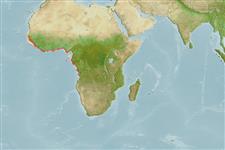>
Carangiformes (Jacks) >
Carangidae (Jacks and pompanos) > Caranginae
Etymology: Hemicaranx: Greek, hemi = the half + French, carangue, the name of a Caribbean fish; 1836 (Ref. 45335).
More on author: Günther.
Environment: milieu / climate zone / depth range / distribution range
ນິເວດວິທະຍາ
ສັດທະເລ; ນ້ຳກ່ອຍ ອາໄສຢູ່ໃກ້ໜ້າດິນໃຕ້ພື້ນທ້ອງນ້ຳ. Tropical
Eastern Atlantic: Along the west African coast from Sierra Leone to Angola (Ref. 57392). Reported from the Sine-Saloum Estuary in Senegal, the Gambia River in Gambia, the Fatala River in Guinea (Ref. 28587) and from Mauritania (Ref. 55783), but this is unconfirmed in Ref. 57392 and needs confirmation.
ຂະໜາດ / ນ້ຳໜັກ / Age
Maturity: Lm ? range ? - ? cm
Max length : 70.0 cm TL ຕົວຜູ້/ບໍ່ມີເພດ; (Ref. 57392); common length : 25.0 cm FL ຕົວຜູ້/ບໍ່ມີເພດ; (Ref. 3195)
ຄີ (ໜາມ)ແຂງຢູ່ຫຼັງປາ (ທັງໝົດ): 8; ຄີຫຼັງຂອງປາ (ຄີອ່ອນ) (ທັງໝົດ): 24-28; ຄີ(ໜາມ) ແຂງຢູ່ຄີກົ້ນປາ
ກຸ່ມປາກະດູກແຂງ
ຄວາມຖີ່ຂອງກຸ່ມຖ່າຍທອດພັນ
ປາທີ່ມີການເຄື່ອນຍ້າຍຈາກທະເລໄປຫານ້ຳຈືດ ແລະນ້ຳຈືດຫາທະເລ
ປາທີ່ມີການເຄື່ອນຍ້າຍຈາກທະເລແລະໄປໄຂ່ຢູ່ນ້ຳຈືດ
ຄີກົ້ນຂອງປາ
ສັດທີ່ມີກະດູກສັນຫັຼງ
ການຖ່າຍທອດທາງກຳມະພັນຈາກພໍ່ແມ່ຫາລູກ 3; ຄີກົ້ນຂອງປາ: 21 - 24. Diagnosis: body elongate (depth comprised 2.4-3.1 times in fork length) and strongly compressed; eyes small; snout short and rounded; mouth small; end of upper jaw extending to below anterior eye margin; teeth present in jaws, absent on vomer; 1st dorsal fin with 7 spines, 2nd dorsal with 1 spine and 24-28 soft rays; anal fin with 2 detached spines, followed by 1 spine and 21-24 soft rays; scales small and cycloid; breast completely scaleless; lateral line arched over anterior half of pectoral fins, its posterior (straight) part with 41-43 scutes; caudal peduncle very slender, without bilateral keels above and below last lateral line scutes (Ref. 57392).
Coloration: back bluish, sides silvery; black spot on upper margin of gill cover; dorsal- and upper caudal-fin lobes broadly black-edged, other fins light; juveniles with 4-5 dark crossbars on back and sides (Ref. 57392).
Adults are found mainly in coastal areas, entering brackish water (Ref. 2683, 57392). Common mostly in midwater and near bottom (Ref. 7079). Young live in association with medusa (jellyfish) (Ref. 57392).
Life cycle and mating behavior
ການຈະເລີນເຕັມໄວ | ການສືບພັນ | ການວາງໄຂ່ | ໄຂ່ | ຄວາມດົກຂອງໄຂ່ປາ | ຕົວອ່ອນ
Smith-Vaniz, W.F., J.-C. Quéro and M. Desoutter, 1990. Carangidae. p. 729-755. In J.C. Quero, J.C. Hureau, C. Karrer, A. Post and L. Saldanha (eds.) Check-list of the fishes of the eastern tropical Atlantic (CLOFETA). JNICT, Lisbon; SEI, Paris; and UNESCO, Paris. Vol. 2. (Ref. 7097)
IUCN Red List Status (Ref. 130435)
Threat to humans
Harmless
Human uses
ການປະມົງ: ທີ່ເປັນການຄ້າໜ້ອຍ
ຂໍ້ມູນຕື່ມອີກ
ຊື່ສາມັນຄຳສັບຄ້າຍຄືກັນການເຜົາໃໝ້ພະລັງງານໂດຍປ່ຽນທາດອາຫານໃນຮ່າງກາຍໃຫ້ກາຍເປັນຊີ້ນແລະໜັງຜູ້ລ້າການສຶກສາຜົນກະທົບຂອງສານຜິດທີ່ມີຜົນກະທົບຕໍ່ລະບົບນິເວດການສືບພັນການຈະເລີນເຕັມໄວການວາງໄຂ່ການສັງລວມການວາງໄຂ່ຄວາມດົກຂອງໄຂ່ປາໄຂ່Egg development
ເອກະສານອ້າງອີງການລ້ຽງສັດນ້ຳຂໍ້ມູນການລ້ຽງສັດນ້ຳສາຍພັນກຳມະພັນElectrophoresesການຖ່າຍທອດທາງກຳມະພັນຈາກພໍ່ແມ່ຫາລູກພະຍາດການປຸງແຕ່ງNutrientsMass conversion
ເຄື່ອງມື
Special reports
Download XML
ແຫຼ່ງອີນເຕີເນັດ
Estimates based on models
Preferred temperature (Ref.
123201): 24.4 - 27.9, mean 26.7 °C (based on 62 cells).
Phylogenetic diversity index (Ref.
82804): PD
50 = 0.5625 [Uniqueness, from 0.5 = low to 2.0 = high].
Bayesian length-weight: a=0.01349 (0.00646 - 0.02815), b=2.96 (2.79 - 3.13), in cm total length, based on LWR estimates for this (Sub)family-body shape (Ref.
93245).
ຊັ້ນເຂດຮ້ອນ (Ref.
69278): 3.9 ±0.6 se; based on size and trophs of closest relatives
ຄວາມຢືດຢຸ່ນ (Ref.
120179): ຂະໜາດກາງ, ປະຊາກອນຕຳ່ສຸດທີ່ໃຊ້ເວລາສອງເທົ່າ 1.4 - 4.4 ປີ (Preliminary K or Fecundity.).
Fishing Vulnerability (Ref.
59153): Moderate to high vulnerability (48 of 100).
Nutrients (Ref.
124155): Calcium = 115 [78, 276] mg/100g; Iron = 1.24 [0.76, 2.35] mg/100g; Protein = 19.3 [18.3, 20.5] %; Omega3 = 0.248 [0.146, 0.435] g/100g; Selenium = 53.5 [29.9, 100.0] μg/100g; VitaminA = 13.3 [4.2, 32.3] μg/100g; Zinc = 1.06 [0.78, 1.46] mg/100g (wet weight);
